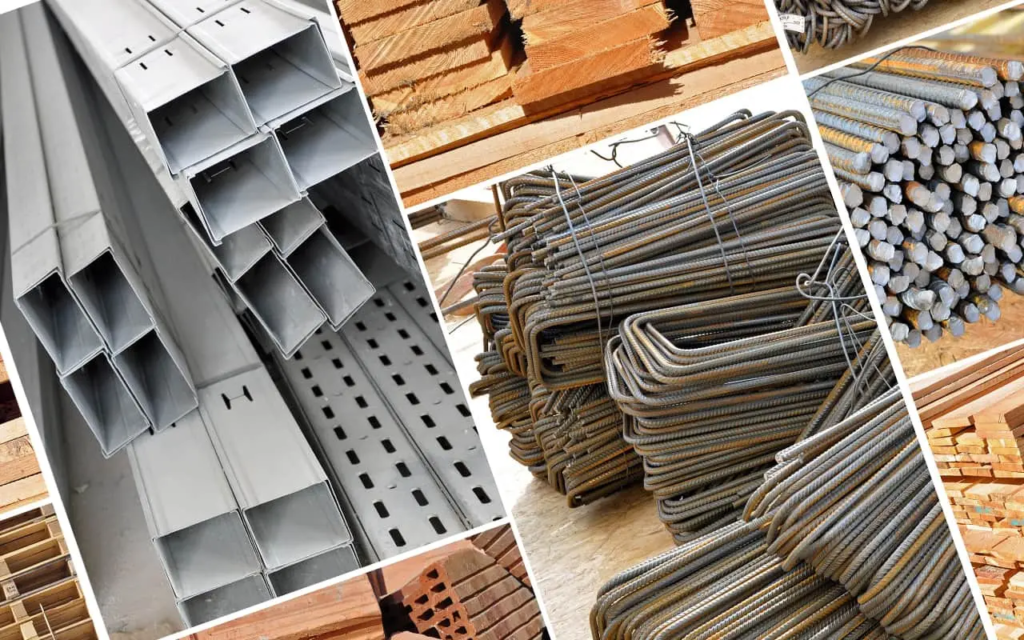
Building materials are the backbone of any construction project. Whether you are constructing a skyscraper, a residential home, or a simple shed, the materials you use determine the durability, aesthetics, and efficiency of the structure. In this comprehensive guide, we explore different types of building materials, their uses, advantages, and why choosing the right material is crucial for successful construction.
Types of Building Materials
1. Natural Building Materials
Natural building materials have been used for centuries in construction. These materials are sourced directly from nature and require minimal processing.
A. Wood
Wood is one of the most commonly used natural building materials due to its strength, flexibility, and insulation properties.
- Types of Wood Used in Construction
- Softwood (Pine, Cedar, Fir)
- Hardwood (Oak, Mahogany, Teak)
- Advantages: Sustainable, easy to work with, aesthetically appealing.
- Disadvantages: Prone to pests, requires maintenance, flammable.
B. Stone
Stone is a durable and robust material widely used in construction for foundations, walls, and flooring.
- Types of Stone Used in Construction
- Granite (Highly durable, weather-resistant)
- Limestone (Common in historic buildings)
- Marble (Luxury, aesthetic appeal)
- Advantages: Fire-resistant, low maintenance, long-lasting.
- Disadvantages: Heavy, expensive, labor-intensive installation.
C. Clay and Mud
Clay and mud have been used in traditional construction methods, especially in adobe and rammed earth buildings.
- Advantages: Eco-friendly, excellent insulation, low cost.
- Disadvantages: Susceptible to water damage, requires frequent maintenance.
2. Man-Made Building Materials
These materials are engineered to enhance the natural properties of their components, making them stronger and more durable.
A. Concrete
Concrete is a mixture of cement, sand, gravel, and water, forming one of the most widely used building materials worldwide.
- Advantages: High durability, fire-resistant, versatile, low maintenance.
- Disadvantages: Heavy, prone to cracking, energy-intensive production.
B. Brick
Bricks are typically made of clay or concrete and are used extensively in wall construction.
- Types of Bricks:
- Burnt Clay Bricks (Traditional, strong, weather-resistant)
- Concrete Bricks (Durable, customizable, energy-efficient)
- Advantages: Cost-effective, weather-resistant, easy to install.
- Disadvantages: Brittle, requires mortar, can absorb water.
C. Steel
Steel is a crucial material in modern construction, particularly for skyscrapers and large-scale structures.
- Advantages: High strength, recyclable, flexible, earthquake-resistant.
- Disadvantages: Expensive, prone to corrosion, requires special handling.
Factors to Consider When Choosing Building Materials
1. Durability and Strength
Choosing materials that can withstand environmental conditions and heavy loads ensures the longevity of the structure.
2. Cost-Effectiveness
While some materials may have a higher initial cost, they might offer long-term savings due to lower maintenance and durability.
3. Sustainability and Eco-Friendliness
With increasing environmental concerns, materials like bamboo, recycled steel, and eco-friendly concrete are becoming more popular.
4. Aesthetic Appeal
The visual appeal of materials like glass, marble, and wood plays a significant role in the architectural design of buildings.
5. Maintenance Requirements
Materials that require minimal upkeep, such as composite materials and treated wood, can save time and resources in the long run.
Innovations in Building Materials
1. Smart Concrete
This material self-heals cracks using bacteria that produce limestone when exposed to water and air.
2. Transparent Aluminum
An advanced material that combines the transparency of glass with the strength of aluminum, making it ideal for modern architecture.
3. Aerogel Insulation
A lightweight material with exceptional thermal insulation, widely used in energy-efficient buildings.
4. 3D Printed Materials
With advancements in technology, 3D printing is revolutionizing the construction industry by producing durable and cost-effective structures.
Conclusion
Choosing the right building materials is critical for ensuring the success, durability, and sustainability of any construction project. Whether opting for natural or man-made materials, considering factors such as cost, strength, sustainability, and maintenance will lead to more informed decisions.
